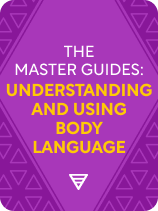

This article is an excerpt from the Shortform book guide to "The Master Guides: Understanding and Using Body Language" by Shortform. Shortform has the world's best summaries and analyses of books you should be reading.
Like this article? Sign up for a free trial here.
Do you want to know how to understand body language? What are some common nonverbal cues, and what do they mean?
To understand body language, you need to understand common nonverbal cues, while also recognizing that body language is unique to the person. Having a good sense of what nonverbal signals usually mean and knowing what strategies to use to reliably read a specific person are both important.
Read more about how to read body language and why context is important.
Understanding Body Language: Where to Start
Do you wish you could better understand the ways people communicate with their body language? Knowing how to understand body language in context plays a huge role in good communication. With an understanding of how to use and interpret body language, you can more easily form connections with others, adapt your nonverbal signals to suit different situations, and even alter your emotional state.
We’ve collected insights from nine experts in nonverbal communication, including self-help authors, former FBI agents, behavioral experts, and leadership specialists. First, we’ll look at a selection of general nonverbal cues you can use to read others in conversation. Then, we’ll discuss some of the most important contextual factors that should influence how we interpret those nonverbal signals.
What Does Friendly Body Language Look Like?
Friendly body language tends to be open and relaxed. These cues communicate interest, trust, and willingness to engage. If you’re approaching or trying to get to know someone, look for these cues to determine whether they’re open to it. Additionally, amend your body language so other people know you’re friendly, too.
Smiling
Schafer and Karlins state in The Like Switch that smiling is one of the most powerful ways that people signal affection and openness. Furthermore, smiling people are seen as more attractive and more confident. When people are open to friendship, they will often look the recipient in the eyes, pause briefly, and then let out a big, warm smile while maintaining eye contact.
Flashing the Eyebrows
According to Schafer and Karlins, another cue that signals friendliness when greeting others is lifting your eyebrows and returning them to their resting position in a single, rapid movement. In The Like Switch, they argue that if someone doesn’t flash their eyebrows in greeting, we subconsciously perceive that person as someone to avoid.
Navarro (The Dictionary of Body Language) adds that we often flash our eyebrows when greeting friends and family. The movement happens in less than a second, signifying that we’re happy and excited to see the people we’re greeting.
Giving Full Attention
In The Fine Art of Small Talk, motivational speaker Debra Fine recommends acting as if there are no distractions in the room when you’re conversing with someone. A friendly person will face you openly and directly, and smile. They will nod, make eye contact, and stay focused on you as you’re speaking.
Schafer and Karlins (The Like Switch) emphasize that torso position says a lot about two people’s interest (or lack thereof) in each other. Generally, people with good rapport orient their torsos toward each other during a conversation. Additionally, the more people lean forward, the more interested they are.
Nonverbal Cues That Signal “Stay Away”
Some body language cues signal that other people should stay away. If you notice these cues in other people, it may be time to back off. They might not be open to forming a relationship with you.
Tension in the Face
Schafer and Karlins (The Like Switch) assert that if some displays a tight jaw, a furrowed brow, and narrowed eyes, this is a sign of unfriendliness. Navarro (The Dictionary of Body Language) also notes that tension in the jaw and narrowed eyes typically signal anger and irritation.
Crossing Arms
Schafer and Karlins state that this is a protective gesture that places a barrier between you and the other person. It signals anxiety and discomfort. Navarro states that people do this when they feel unsure or unsafe because folded arms cover the soft front torso, which contains many of the most important and vulnerable internal organs. Therefore, we instinctively protect this area.
Angling the Feet Away From Someone
Navarro (The Dictionary of Body Language) states that people often angle their feet away from someone they don’t like. In social situations, this is a reliable indicator of people’s true feelings, even if they’re smiling and being polite.
Why Context Is Important in Body Language
Though you can make general statements about how to read nonverbal cues, there’s no such thing as completely universal body language. If you want to understand the emotions of others, you must also understand the factors that lead to differences in body language from person to person. This helps you avoid misunderstandings that can come from interpreting nonverbal cues out of context.
Contextual Factor #1: Understand What “Normal” Body Language Is for an Individual
In The Dictionary of Body Language, former FBI agent Joe Navarro states that when you’re interpreting body language cues, it’s important to consider whether the action is ordinary or unusual for the person doing it. Factors such as personality type, neurodivergence, and culture can influence how someone communicates nonverbally. In The Laws of Human Nature, Greene also warns not to universally assign cues to certain emotions: Different people may use the same nonverbal cue to express different emotions. For example, one person may speak louder when they’re excited; another may do so when they’re upset.
Get a Baseline Understanding of People’s Body Language
To understand when body language indicates a certain emotion for a certain person, it’s important to establish their baseline of “normal” body language: a set of nonverbal cues that signal they’re in a neutral emotional state. Once you have this knowledge of their “normal” body language, you can more easily notice and interpret cues that represent strong emotions for them—the cues will differ from the baseline.
For example, after establishing a baseline for one person, you may find that they habitually tap their foot and it doesn’t indicate anything specific about how they’re feeling. However, they don’t typically tap their fingers—if they’re doing so, this may suggest they’re experiencing a stronger emotion such as anxiety or impatience.
In What Every Body Is Saying, Joe Navarro and Marvin Karlins further explain how to determine and use this baseline. First, make a mental record of a person’s behaviors at the start of your interaction. This allows you to get a baseline to measure your future observations against.
Second, when analyzing someone’s baseline behavior, assess it in the context of the situation they’re in. Consider things such as their surroundings and what they’re doing there so you can know what behaviors to expect and what behaviors are abnormal. For example, you should expect someone at a job interview to show more nervous behavior than someone shopping at a grocery store.
Greene (The Laws of Human Nature) also offers advice for establishing someone’s baseline body language. He advises that when you’re studying a certain person, watch her interact with a variety of people to figure out her default emotion. Then, pay attention to changes from this baseline. For instance, if a normally cheerful person is smiling, that doesn’t tell you much. However, if a normally neutral person is smiling, that probably indicates emotion.
Contextual Factor #2: Consider All Nonverbal Cues Together
In The Dictionary of Body Language, Navarro suggests also taking a person’s whole body language into account before deciding what a particular cue means. This can prevent you from misinterpreting their nonverbal communication—the combination of cues will typically paint a clearer picture of their emotional state than an isolated one.
For example, when someone smiles at another person, we typically perceive it as a cue of affection, kindness, or joy. However, a smile on its own doesn’t present the whole picture. If the person is displaying signs of tension or discomfort as well—if the muscles around their eyes are tense, their feet are pointed away from the person they’re talking to, and so on—then their smile may not represent true affection or friendliness, but forced friendliness that hides discomfort.
Shortform Resources
For more information on using and interpreting body language, see the following Shortform guides:
- The Definitive Book of Body Language, Allan Pease and Barbara Pease
- What Every Body Is Saying, Joe Navarro and Marvin Karlins
- The Dictionary of Body Language, Joe Navarro
- The Like Switch, Jack Schafer and Marvin Karlins
- How to Talk to Anyone, Leil Lowndes
- Presence, Amy Cuddy
- The Laws of Human Nature, Robert Greene
- The Charisma Myth, Olivia Fox Cabane
- The Fine Art of Small Talk, Debra Fine
- Surrounded by Idiots, Thomas Erikson
For more information on communicating effectively, see:
- Emotional Intelligence, Daniel Goleman
- Fierce Conversations, Susan Scott
- You’re Not Listening, Kate Murphy
- Words That Change Minds, Shelle Rose Charvet
- Communication Skills Training, James Williams
- Better Small Talk, Patrick King
- Just Listen, Mark Goulston

———End of Preview———
Like what you just read? Read the rest of the world's best book summary and analysis of Shortform's "The Master Guides: Understanding and Using Body Language" at Shortform.
Here's what you'll find in our full The Master Guides: Understanding and Using Body Language summary:
- How to better understand nonverbal communication
- How to use and interpret body language to form connections
- The body language you should avoid if you're looking to make friends






